Top 50 Computer Science Journals To Publish in 2025

Computer Science Journals are one of the most sought after journal for publishing after medical journals. Every year the landscape of computer science research continues to evolve rapidly and that makes the selection of appropriate journals more critical than ever for researchers, academics, and PhD students.
Currently there are over 28,000 journals indexed in major databases like Scous, Web of Science and ABDC, identifying the most prestigious and impactful computer science journals has become harder and harder.
This particular article gives you a comprehensive guide to choosing the best computer science journal and we have presented with the definitive ranking of the top 50 computer science journals based on multiple authoritative metrics including Journal Impact Factor (JIF), CiteScore, SJR rankings, and CORE classifications.
This list was analyzed based on the combined data from Clarivate’s Journal Citation Reports, Scimago Journal Rankings, IEEE rankings, ACM publications, and the Computing Research and Education Association’s CORE rankings.
Contents
- 1 Top 10 Computer Science Journals by Impact Factor
- 2 Top Computer Science Publishers
- 3 Top Subject Areas in Computer Science Journals
- 4 Regional and Institutional Contibutions in Journals
- 5 How to Select Computer Science Journals for Publishing?
- 6 Emerging Trends and Future Directions
- 7 Strategic Recommendations for Researchers
Top 10 Computer Science Journals by Impact Factor
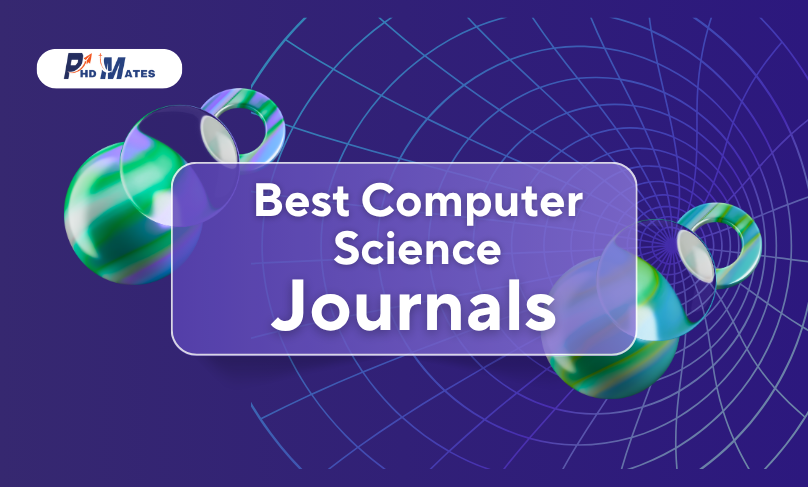
The elite tier of computer science journals contains exceptional research quality and global influence that is exactly why researcher like to target these journals. When it comes to the overall best CS Journal – IEEE Transactions on Pattern Analysis and Machine Intelligence leads with an unprecedented impact factor of 25.25, reflecting its central role in artificial intelligence and machine learning research.
The top 10 journals collectively represent the pinnacle of computer science publishing, with impact factors ranging from 16.17 to 25.25.
Also remember that Computer Science Journals Publishers publish huge amount of manuscripts every day.
Below is the list of top 50 Computer Science Journals –
| Rank | Journal Name | Impact Factor | Publisher | Subject Area | Quartile | CORE Ranking |
|---|---|---|---|---|---|---|
| 1 | IEEE Transactions on Pattern Analysis and Machine Intelligence | 25.25 | IEEE | AI/Pattern Recognition | Q1 | A+ |
| 2 | IEEE Communications Magazine | 22.11 | IEEE | Communications | Q1 | B |
| 3 | IEEE Communications Surveys and Tutorials | 20.3 | IEEE | Communications | Q1 | B |
| 4 | IEEE Transactions on Image Processing | 20.13 | IEEE | Image Processing | Q1 | A+ |
| 5 | IEEE Journal on Selected Areas in Communications | 19.8 | IEEE | Communications | Q1 | B |
| 6 | IEEE Transactions on Wireless Communications | 18.64 | IEEE | Wireless Communications | Q1 | A |
| 7 | IEEE Internet of Things Journal | 17.66 | IEEE | IoT/Communications | Q1 | B |
| 8 | Pattern Recognition | 17.32 | Elsevier | Pattern Recognition | Q1 | A |
| 9 | IEEE Transactions on Communications | 16.34 | IEEE | Communications | Q1 | B |
| 10 | ACM Computing Surveys | 16.17 | ACM | Computer Science Theory | Q1 | A+ |
| 11 | IEEE Transactions on Neural Networks and Learning Systems | 16.17 | IEEE | Machine Learning/AI | Q1 | A |
| 12 | IEEE Transactions on Vehicular Technology | 15.84 | IEEE | Transportation | Q1 | B |
| 13 | IEEE Transactions on Cybernetics | 15.84 | IEEE | Cybernetics/AI | Q1 | B |
| 14 | IEEE Transactions on Signal Processing | 15.68 | IEEE | Signal Processing | Q1 | B |
| 15 | IEEE Transactions on Industrial Informatics | 15.51 | IEEE | Industrial Informatics | Q1 | B |
| 16 | Future Generation Computer Systems | 15.18 | Elsevier | Computer Systems | Q1 | A |
| 17 | Neurocomputing | 15.18 | Elsevier | Neural Computing | Q1 | B |
| 18 | IEEE Wireless Communications | 14.36 | IEEE | Wireless Communications | Q1 | B |
| 19 | IEEE Transactions on Knowledge and Data Engineering | 14.36 | IEEE | Data Engineering | Q1 | A |
| 20 | Information Sciences | 14.36 | Elsevier | Information Sciences | Q1 | B |
| 21 | IEEE Transactions on Automatic Control | 14.03 | IEEE | Control Systems | Q1 | A+ |
| 22 | IEEE Signal Processing Magazine | 13.86 | IEEE | Signal Processing | Q1 | B |
| 23 | Journal of Machine Learning Research | 13.37 | MIT Press | Machine Learning | Q1 | A+ |
| 24 | Automatica | 13.2 | Elsevier | Control Systems | Q1 | A+ |
| 25 | ACM Transactions on Graphics | 13.2 | ACM | Computer Graphics | Q1 | A+ |
| 26 | IEEE Transactions on Information Forensics and Security | 13.04 | IEEE | Security/Forensics | Q1 | B |
| 27 | Proceedings of the IEEE | 13.04 | IEEE | General CS | Q1 | B |
| 28 | IEEE Transactions on Multimedia | 12.87 | IEEE | Multimedia | Q1 | B |
| 29 | International Journal of Computer Vision | 12.71 | Springer | Computer Vision | Q1 | A |
| 30 | IEEE Transactions on Systems, Man, and Cybernetics: Systems | 12.54 | IEEE | Systems/Cybernetics | Q1 | B |
| 31 | IEEE Transactions on Intelligent Transportation Systems | 12.21 | IEEE | Transportation | Q1 | B |
| 32 | IEEE Transactions on Information Theory | 12.21 | IEEE | Information Theory | Q1 | A+ |
| 33 | Knowledge-Based Systems | 11.71 | Elsevier | Knowledge Systems | Q1 | B |
| 34 | IEEE Transactions on Industrial Electronics | 11.55 | IEEE | Industrial Electronics | Q1 | B |
| 35 | International Journal of Robotics Research | 11.38 | Sage | Robotics | Q1 | A |
| 36 | IEEE Transactions on Mobile Computing | 11.38 | IEEE | Mobile Computing | Q1 | A |
| 37 | Communications of the ACM | 11.22 | ACM | General CS | Q1 | B |
| 38 | IEEE Transactions on Visualization and Computer Graphics | 10.89 | IEEE | Visualization | Q1 | A |
| 39 | Information Fusion | 10.89 | Elsevier | Information Fusion | Q1 | B |
| 40 | IEEE Transactions on Smart Grid | 10.72 | IEEE | Smart Grid | Q1 | B |
| 41 | IEEE Transactions on Medical Imaging | 10.72 | IEEE | Medical Imaging | Q1 | B |
| 42 | IEEE Communications Letters | 10.72 | IEEE | Communications | Q1 | B |
| 43 | IEEE Robotics and Automation Letters | 10.72 | IEEE | Robotics | Q1 | B |
| 44 | Proceedings of the VLDB Endowment | 10.56 | Morgan Kaufmann | Database Systems | Q1 | A+ |
| 45 | IEEE Transactions on Geoscience and Remote Sensing | 10.39 | IEEE | Geoscience/Remote Sensing | Q1 | B |
| 46 | IEEE Network | 10.39 | IEEE | Networking | Q1 | B |
| 47 | IEEE/ACM Transactions on Networking | 10.39 | IEEE | Networking | Q1 | A+ |
| 48 | IEEE Transactions on Fuzzy Systems | 10.39 | IEEE | Fuzzy Systems | Q1 | A+ |
| 49 | Expert Systems with Applications | 10.39 | Elsevier | Expert Systems | Q1 | A |
| 50 | IEEE Transactions on Software Engineering | 9.9 | IEEE | Software Engineering | Q1 | A+ |
From the above list it is very evident that IEEE dominates the top rankings, holding 7 of the top 10 positions, while ACM and Elsevier each contribute one journal to this elite group of top 50 Computer Science Journals. This concentration reflects IEEE’s strategic focus on high-impact research areas including pattern recognition, communications, and image processing.
The Communications and Networking Domain shows is very strongly represented, with IEEE Communications Magazine (22.11), IEEE Communications Surveys and Tutorials (20.30), and IEEE Journal on Selected Areas in Communications (19.80) all securing top-10 positions in the list. This showcases the critical importance of connectivity and networking in modern computing systems.
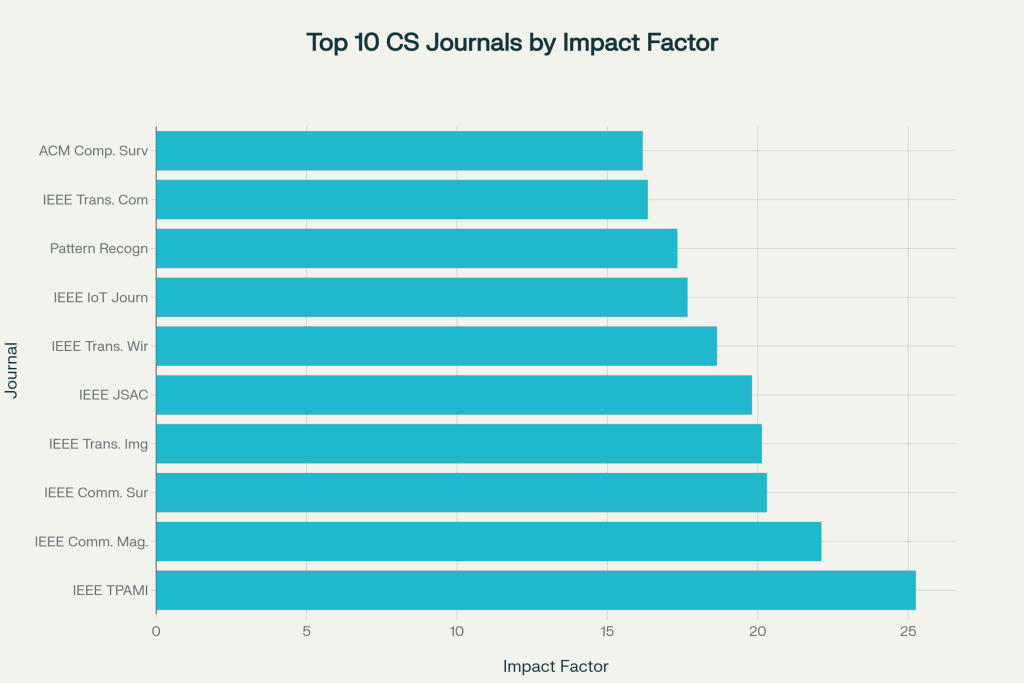
Top Computer Science Publishers
The publisher landscape reveals significant concentration within the computer science journal ecosystem. 70% of the top 50 journals ranking is maintained by IEEE having 35 journals.This concentration reflects IEEE’s historical leadership in electrical engineering and computer science publishing, combined with its extensive professional society network.
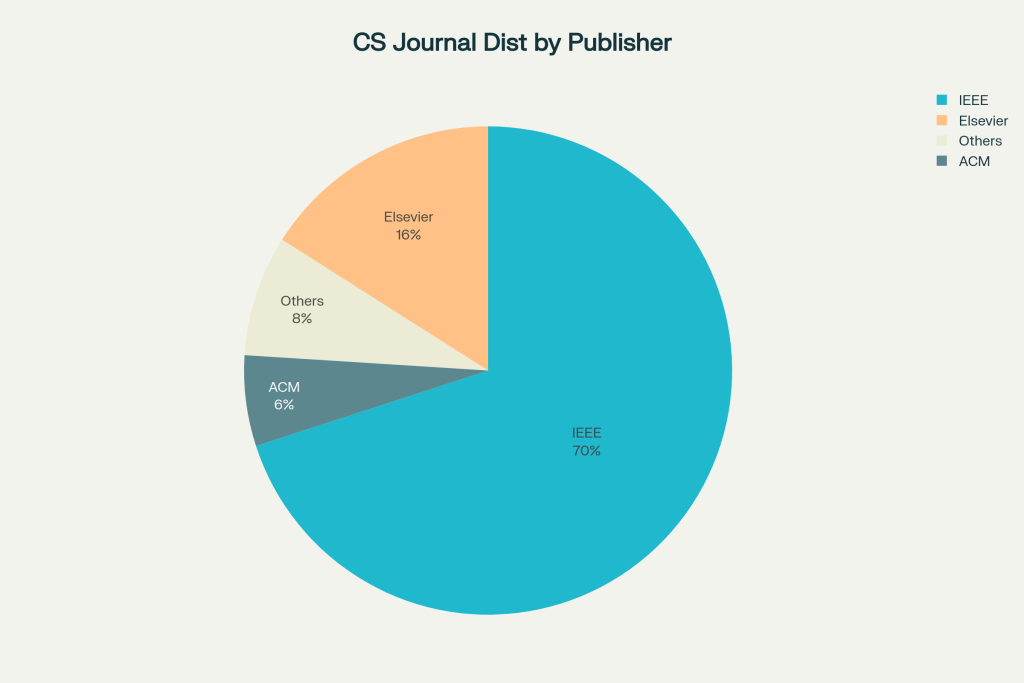
Elsevier holds the second position with 16% market share, publishing 8 of the top 50 journals including high-impact titles like Pattern Recognition (17.32) and Future Generation Computer Systems (15.18). The Association for Computing Machinery (ACM) contributes 6% with three highly prestigious journals: ACM Computing Surveys (16.17), ACM Transactions on Graphics (13.20), and Communications of the ACM (11.22).
The “Others” category encompasses 8% of the top journals, including prestigious publishers like MIT Press (Journal of Machine Learning Research), Springer, Sage, and Morgan Kaufmann. This diversity indicates that while IEEE dominates, excellence in computer science publishing extends across multiple publishing houses.
Top Subject Areas in Computer Science Journals
Looking the distribution of subject areas in the current research priorities – Communications emerges as the dominant field in the research with 24% of top journals, encompassing wireless communications, networking protocols, and signal processing research.
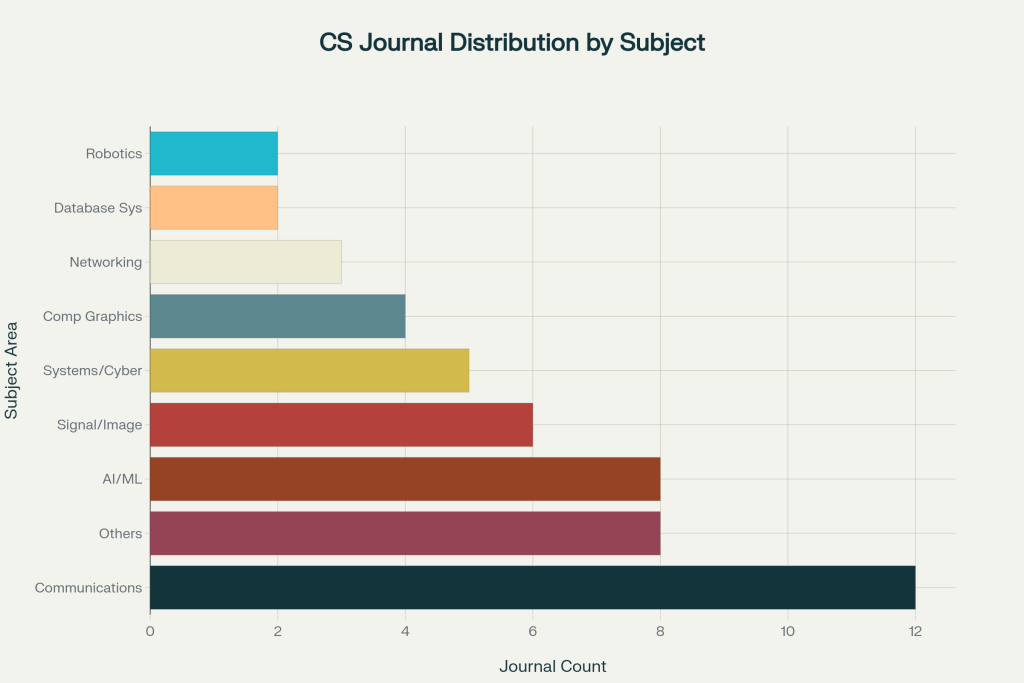
Artificial Intelligence and Machine Learning represent 16% of premier journals, highlighting the explosive growth in these fields driven by advances in deep learning, neural networks, and intelligent systems. This proportion likely underrepresents the actual research volume, as AI methods now permeate virtually all computer science domains.
Signal and Image Processing accounts for 12% of the top journals, which showcases the continued importance of multimedia computing, computer vision, and digital signal processing in modern applications. The integration of AI with signal processing has a huge scope of publication opportunities.
Systems and Cybernetics represent 10% of publication in terms of subject, which encompasses – distributed systems, control theory, and human-machine interaction research. The emergence of cyber-physical systems and IoT applications has made this subject of research gain more importance again.
Regional and Institutional Contibutions in Journals
Computer Science Genre of research gets global contribution, the strong contribution of institutes and countries contribution also gives the context of global advancement of the institute/country. It is observed that most American institutions dominate the editorial boards and author contributions of the top-tier journals, particularly in artificial intelligence, systems, and theoretical computer science.
European contributions show strength in algorithms, formal methods, and software engineering, with strong representation in journals like Theoretical Computer Science and Formal Methods in System Design. The CORE rankings from Australia provide an alternative perspective that emphasizes theoretical contributions and long-term research impact over short-term citation metrics.
Also, Asian research contributions have grown substantially in the past few years, particularly in areas like mobile computing, IoT systems, and manufacturing applications. IEEE Transactions on Industrial Informatics and IEEE Internet of Things Journal reflect this global shift toward practical, application-oriented research.
How to Select Computer Science Journals for Publishing?
Selecting appropriate journals isn’t that easy with thousands of Journals in Computer Science. While Choosing a journal you have balance multiple factors and not simply depend on impact factor rankings. Researchers should consider audience alignment, review timeline, and open access policies alongside prestige metrics. The most prestigious journals often have acceptance rates below 20%, requiring exceptional research contributions.
Early-career researchers may benefit from a portfolio approach, targeting a mix of top-tier venues for breakthrough work and solid second-tier journals for incremental contributions. The CORE A+ rankings provide excellent guidance for identifying journals with strong academic recognition even if they lack the highest impact factors.
Subject specialization significantly influences journal selection strategy. Highly specialized areas like quantum computing or bioinformatics may have premier venues that don’t appear in general computer science rankings but are essential for reaching the appropriate research community.
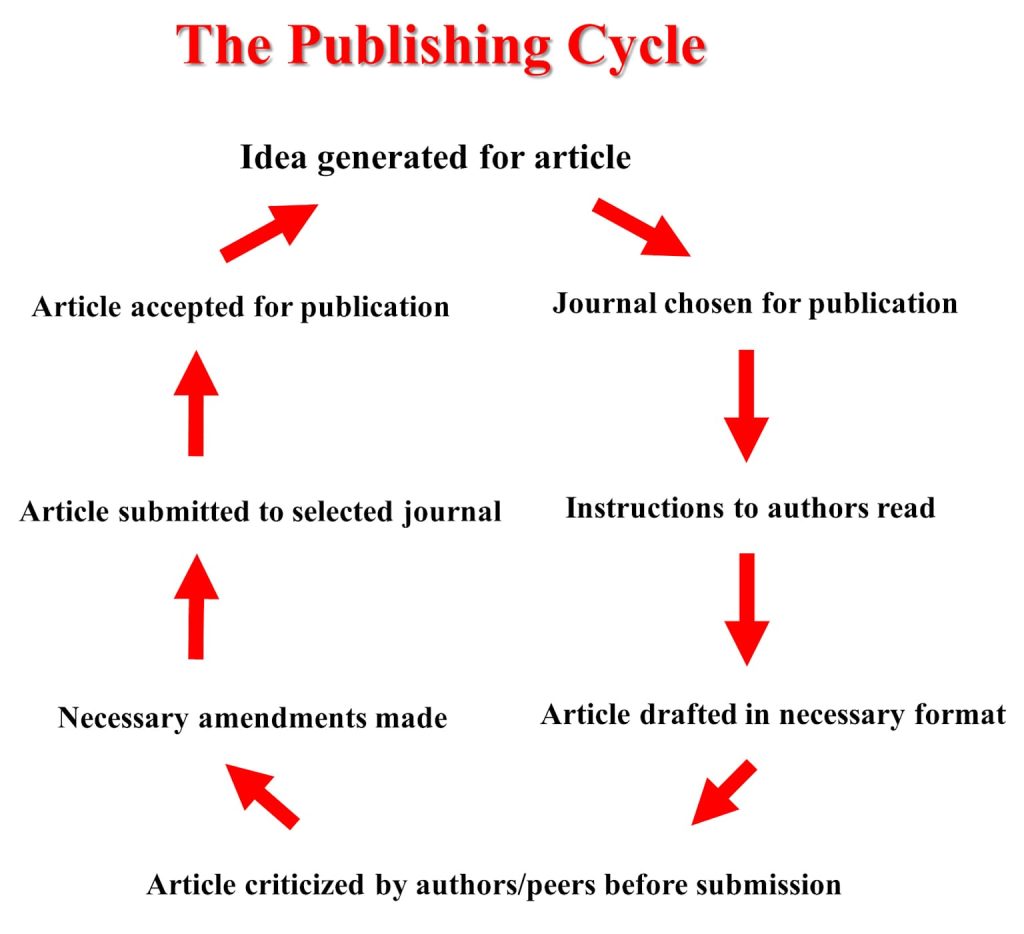
Publication timeline considerations become critical for career milestones. Some prestigious journals maintain review periods exceeding 12 months, while others offer expedited tracks for exceptional contributions. Understanding these patterns helps researchers align submission strategies with career objectives.
Emerging Trends and Future Directions
The computer science journal landscape continues evolving rapidly, driven by technological advances and changing research priorities. Open access publishing gains momentum, with major publishers establishing hybrid models and new fully open journals achieving rapid prestige growth.
Interdisciplinary research creates opportunities for high-impact publications that bridge computer science with fields like biology, medicine, materials science, and social sciences.Journals that successfully navigate these boundaries often achieve exceptional impact factors through broader audience appeal.
Artificial intelligence integration across all computer science domains suggests that AI-related research will increasingly appear in previously unrelated venues. Traditional systems, networks, and software engineering journals now regularly publish AI-enhanced research.
Sustainability and ethical computing emerge as priority themes, likely to influence future journal development and editorial policies. The integration of environmental impact and social responsibility considerations into computer science research represents a significant trend.
Strategic Recommendations for Researchers
Based on comprehensive analysis of the top 50 computer science journals, several strategic recommendations emerge for researchers at different career stages. Graduate students should focus on solid second-tier journals (impact factors 8-12) to build publication records while developing the exceptional research required for premier venues.
Postdocs and early-career faculty benefit from targeting top-15 journals where possible, as these publications carry significant weight in hiring and promotion decisions. The prestige differential between ranks 10-15 and ranks 20-30 can be substantial in competitive academic markets.
Established researchers should maintain presence in premier venues while also contributing to community building through quality second-tier publications and service activities. Editorial board membership and reviewing for top journals becomes increasingly important for senior researchers.
Industry researchers may prioritize different venues that emphasize practical applications and technology transfer over pure academic metrics. IEEE magazines and applied computing journals often provide better channels for reaching practitioner audiences.
This comprehensive analysis of the 50 best computer science journals provides researchers with the data-driven insights needed to make informed publication decisions. The dominance of IEEE publications, the strength of AI and communications research, and the continued importance of impact factor metrics all inform strategic approaches to academic publishing in computer science. Success requires understanding both the quantitative rankings and the qualitative factors that determine research impact within specific communities.
